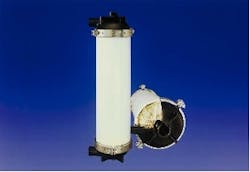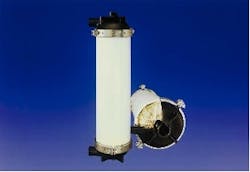New Membrane System Offers Reduced Maintenance
F.B. Leopold and Hydranautics High Performance Membrane Products have formed a partnership to produce the Leopold HYDRAcapRegistered ultrafiltration process membrane system.
The system uses hollow-fiber capillary membranes to remove colloidal matter and pathogens, including giardia, cryptosporidium and other bacteria and viruses. It can reduce turbidity to less than 0.06 NTU, surpassing anticipated U.S. Environmental Protection Agency standards. Its performance in even very turbid waters virtually eliminates the need for pretreatment chemicals and multiple unit operations.
The Hydracap system, developed by Hydranautics, can further cut operating costs by achieving water return levels of 95 percent and more with water recovery. Suitable applications include treatment of surface water, ground water under the influence of surface water and spent filter backwash recovery.
How it Works
Influent enters the end of the Hydracap membrane element and flows along and through the inside of its hollow-fiber, semipermeable capillary membranes. The permanently hydrophilic polyether sulfone membranes block passage of particulates larger than 0.01 micron but allow passage of pure water into the central core tube. The membranes provide 4-log removal and higher for giardia and cryptosporidium.
Since it operates at low transmembrane pressures (typically less than 15 psig), the energy consumption of the system is lower than other membrane processes.
The membrane elements are periodically cleaned by backflushing. The water follows an "inside-out" path, entering the membrane element through the central core tube and passing through the walls of the hollow-fiber capillary membranes to dislodge material trapped among the fibers and flush it away through the concentrate tube.
The membranes are resistant to a wide range of cleaning agents, eliminating the need for additional equipment and simplifying sanitation. Chlorine and peroxide tolerance is 200 ppm. Membranes can be cleaned with sodium hypochlorite, so no proprietary cleaning chemicals are required. The Hydracap installations tolerate pH levels ranging from 1-13.
Hydracap membrane elements are 40 to 60 inches long and are arranged together in modules designed and fabricated to specific plant requirements and treatability study data. Nominal membrane area is 320 ft² for 40 inch elements and 500 ft² for 60 inch elements. The footprint of the system is small, reducing space requirements in existing installations and lowering the cost of new plant construction.
Typical filtrate flux range is 35-85 gallons of flux per day. Maximum operating temperature is 104°F, with a maximum feed pressure of 100 psig. Transmembrane pressure range is 4-22 psig.
Leopold takes responsibility for the design, engineering, fabrication, installation and commissioning of Hydracap systems. Employing pilot plants, Leopold secures data under actual operating conditions then assists engineers in preparing custom-engineered plants.

